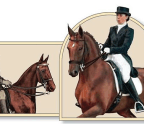BEYOND THE BALE

If there’s any common ground in the equestrian world, it’s covered in hay. No matter the breed in the paddocks or the type of saddles in the tack room, every facility that houses horses will have a loft, shed or other space full of hay. Dressage riders, team ropers and trail riders alike toss flakes of hay over fences---and probably end up brushing the excess off their shirts.
Hay is a uniter of horses, too: A humble lesson horse and a racehorse may almost seem like different species until you place a net full of sweet-smelling wisps in front of each. Then they are both simply happy horses.
Given the essential role hay plays in our everyday lives, it’s a bit surprising that we horse people don’t know more about it. Yes, we know it’s dried grass, and yes, we understand it’s the foundation of a healthy equine diet. And every seasoned horse keeper is familiar with the hallmarks of good quality hay. But when it comes to the specific plant types, their attributes and exactly how much to feed, we may be less informed than we realize or want to admit.
“Often horse owners understand their horses very well and pay close attention to feet, teeth and health care, but can’t tell you what kind of grass is growing in the pasture,” says equine nutritionist Burton Staniar, PhD, of Pennsylvania State University. “The plants horses are eating are not the horsemen’s main focus, yet forage is the basis of what keeps their horses healthy and
You’re reading a preview, subscribe to read more.
Start your free 30 days





